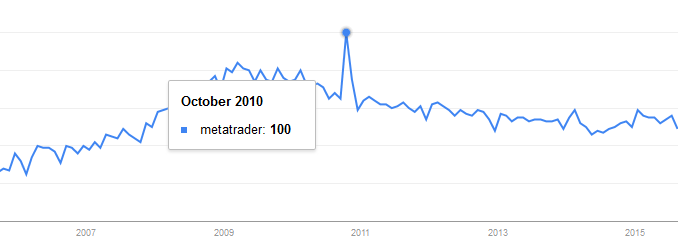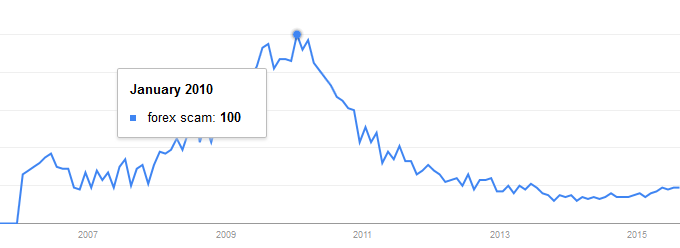
Almost five years ago, I have posted an overview of the popularity trends for the
As seen on the chart below, the popularity of the search term forex was in a general downtrend since October 2008, which coincided with the global financial crisis and the beginning of the Great Recession. It looks like the potential traders had their disposable income reduced and lost interested in currency trading. The bottom of the popularity trend seems to have been reached in June 2014:

The chart of the stocks popularity is used for a comparison here to give some scale in terms of an alternative investment vehicle. Similar to forex, the search term had its popularity peak in October 2008, but, unlike forex, the search term was already in a

Another trading concept of interest — metatrader — shows a completely different picture of Google search trending. The keyword is down in popularity since February 2009, but has its maximum in October 2010. The first pivot point is probably caused by the lack of an Automated Trading Championship in 2009 — the fact that prevented the trend popularity from growing. The peak was probably caused by adoption of MetaTrader 5 live accounts that followed the first one announced in September 2010. Although the bottom is seen in May 2014, it is hardly out of a downtrend as of now:

The final point in my research of the

I would like to complement this modest study of the Forex popularity via Google Trends with some data from the Twitter statistics. Statweestics offers a nice tool for measuring the popularity of the top 500 hashtags on Twitter. Unfortunately, the data is very limited — only the years 2011–2015 are available. Obviously, the data for 2015 are not final yet. Still, the downtrend from 2011 through 2014 is evident. 2015 value is either a pickup in popularity or, more likely, an aberration that will disappear after a lot of seasonal hashtags kick in before the end of the year:
If you have any questions, comments or opinions regarding the state of Forex popularity in the Internet, please feel free to reply suing the commentary form below.